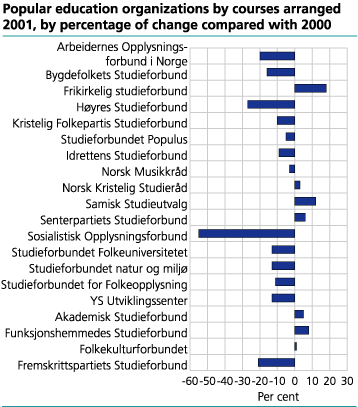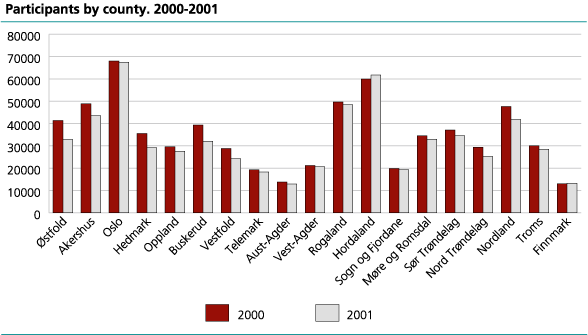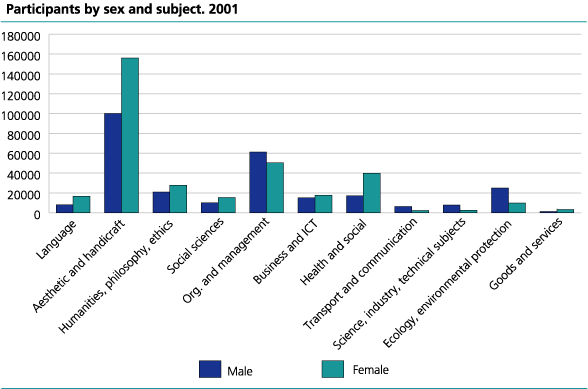Content
Published:
This is an archived release.
Decrease in courses and participants
In the last few years significantly fewer courses have been arranged by popular education organizations. In 2000 the decrease from 1999 was merely 2 per cent. In 2001 there was a 10-per cent decrease compared with the previous year.
In 2001 close to 615 000 participants attended 55 000 different courses arranged by popular education organizations. Compared to the previous year there were 52 300 fewer participants and 5 800 fewer courses. Norsk musikkråd was the one organization that reported both the highest number of courses and the highest number of participants during 2001. Norsk musikkråd arranged 11 500 courses and reported a total number of 166 000 participants. Even so, this was a 3-percentage decline in number of courses compared to the previous year.
Norsk Musikkråd, Arbeidernes Opplysningsforbund and Studieforbundet Folkeuniversitetet were responsible for 54 per cent of all courses arranged by popular education organizations.
Even though most popular education organizations experienced reduced activity in 2001 compared to the previous year, there were some notable exceptions. Frikirkelig Studieforbund experienced an 18-percentage increase in total number of courses compared to 2000. Samisk Studieutvalg arranged 12 per cent more courses than the previous year and also had a significant growth in number of participants (26 per cent).
Eleven participants per course
Despite reduced activity during 2001, the average attendance at each course arranged was stable at 11 participants per course. Akademisk Studieforbund had the highest participation rate with 41 participants per course. In contrast, Samisk Studieutvalg had the lowest participation rate with 5 participants per course.
Geographical differences
County wise, Hordaland County arranged the highest number of courses, while Oslo County had the highest number of participants during 2001. Oslo County had on average 14 participants per course. At the bottom, Aust Agder County had both the fewest number of courses and least number of participants of all counties during 2001.
Common to all counties, except for Oslo, was that the age group consisting of participants between 30 and 49 years of age dominated many courses during 2001. In Oslo, young participants between 14 and 29 years of age represented the largest group, but they were only marginally larger than the age group 30-49. More women than men attended courses in all counties except for Sogn and Fjordane County which had 3 per cent more men than women.
Sex and age influence choice of course
Similar to previous years aesthetic and handicraft courses were the most popular courses, totaling almost 22 000 courses and more than 256 000 participants. 77 per cent of these participants attended a music course.
All the different main subjects, except for one, experienced a drop in courses and participants during 2001. The number of service courses had the steepest decline during 2001, 38 per cent fewer than the previous year. On the other hand, humanities and philosophical subjects experienced a 6-percentage growth in courses and a 5-percentage growth in participants during 2001.
More than half of all participants, 56 per cent, were women. Female participants were in majority in most main subjects, also in business and ICT courses. In contrast, male participants dominated courses in science, industrial and technical subjects, transport and communication, natural resource management, ecology, environmental protection and outdoor recreation.
Age also influences choice of course. The age group 30-49 was in majority in many but not all main subjects. In language courses they were outnumbered by the age group of 50 years and older and in aesthetic courses by the age group 14-29.
Tables:
Contact
-
Hossein Moafi
E-mail: hossein.moafi@ssb.no
tel.: (+47) 90 40 31 19



